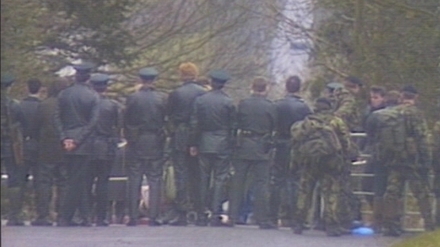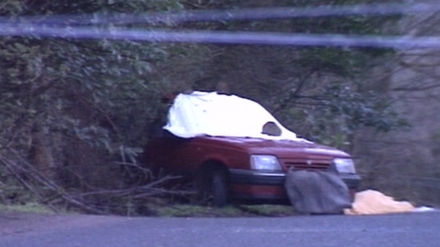 RTÉ's North-East Correspondent Richard Dowling gives a summary of the evidence given so far in the Smithwick Tribunal, which resumes tomorrow.
RTÉ's North-East Correspondent Richard Dowling gives a summary of the evidence given so far in the Smithwick Tribunal, which resumes tomorrow.
The Smithwick Tribunal has now heard eight days of evidence. During that time we have heard much about the murder of the two RUC officers, Chief Supt Harry Breen and Supt Bob Buchanan but very little direct evidence about collusion.
That is likely to change in the coming weeks but for now the evidence has largely centred on who knew what and when.
There's no doubt that the most important witness we've heard from so far is Alan Mains. He was a sergeant who ran the office of Chief Supt Breen back in 1989. He was adamant that just before his boss left for the meeting in Dundalk Garda Station he told him he was uneasy about travelling south because he believed some gardaí there were in the pay of local republican, Thomas 'Slab' Murphy. The witness said the Chief Superintendent specifically mentioned then Detective Sergeant Owen Corrigan.
What made his boss even more uneasy is that the meeting in Dundalk was to discuss a cross border operation against Mr Murphy himself.
Mr Mains, who retired with the rank of Detective Inspector based in Newry, said he was supposed to travel with the Chief Superintendent but he didn't because he had a rugby match. Instead Supt Buchanan went.
Other witnesses, however, had said earlier in the Tribunal that the Superintendent was always supposed to travel. The other point worth mentioning which arose during his cross examination was the fact that Mr Mains never committed the name of Owen Corrigan to any document until 11 years after the murders.
The reason he gave for that was that he was told by a senior detective not to do so when making his statement and that when he raised the issue of Mr Corrigan working for the IRA with the then Chief Constable Sir John Hermon, the idea had been dismissed.
Mr Mains also claimed that when Mr Corrigan was abducted in 1996, he was contacted by the gardaí as they needed RUC help to try and find him.
He said he was told by the gardaí that Mr Corrigan had been abducted because he owed paramilitaries money.
There was controversial evidence given at the start from senior RUC officers.

Witness 18, an Assistant Chief Constable told the Tribunal that he had told Breen and Buchanan at a meeting that they should not travel south for a meeting with the gardaí. They disobeyed an order and they died, he said.
However, Assistant Chief Constable David Cushely said he doubted whether such an order had been given and if it was whether the two RUC men would have disobeyed an order. He wasn't alone in that view as it was echoed by other former RUC officers.
ACC Cushley also told the Tribunal in his evidence on Friday, 10 June that he had no security concerns about Dundalk Garda Station at all.
Over the last number of days of evidence, the Tribunal heard from several gardaí.
All of them refute the allegation there was an IRA mole among them. One witness, former Chief Superintendent John Nolan, whom the two RUC men had come to visit, surprisingly said he had never heard of the rumours of collusion until ten years after the murders. This is despite the fact it was on the television news and in the newspapers the day after the two men had died.
Several gardaí also expressed concern about the lack of security measures taken by Supt Buchanan during his many visits south of the border.
There was agreement too among the gardaí and former RUC men about the dangers posed by the IRA in south Armagh. All witnesses agreed they were a cautious but ruthlessly efficient organisation. They planned their operations well, rarely took chances and would have been carrying out surveillance both on RUC and gardai. His frequent visits and the fact he hadn't changed his car for over two years would have made Superintendent Buchanan easy to identify.

As a result several witnesses said they didn't believe the IRA would have needed a mole to carry out this operation nor would they have just carried out this operation on an ad hoc basis.
Other evidence emerged during the week about the ambush when it was revealed that one of the weapons used to kill the two RUC men had been used in many other attacks including the Kingsmills massacre.
In that attack ten Protestant workers were killed in January 1976 when they were taken from a minibus and shot by republicans near the village of Kingsmills in Armagh. The IRA was on ceasefire at the time and a previously unknown republican group claimed responsibility. However the IRA have admitted several other attacks in which the same gun, a .223 calibre AR-15 Armalite, was used – including the ambush of Breen and Buchanan – so there can be no doubt that the IRA was behind the Kingsmills massacre.
Another killing, which the gun was involved in, was that of Eamon Maguire. His body was found in Cullaville, south Armagh, in September 1987 and the IRA said they killed him because he was an informer.
His death has been linked to the British agent known as Stakeknife who was involved with the IRA's internal security unit, which was set up to find informers. The man who denies he is Stakeknife, Freddie Scappaticci, has legal representation at the Smithwick Tribunal.
As well as these killings, the weapon was involved in several other murders and attempted murders during its 16 years in use by the IRA.
A dispute has also emerged between the three gardaí being probed by the Smithwick Tribunal.
Former garda Finbarr Hickey claimed he was asked by his sergeant Leo Colton to sign blank passport forms. Those forms ended up in the hands of the Provisional IRA and Hickey ended up in prison. Colton was investigated but never charged and has always denied Hickey's claims.
Retired detectives Jim Lane and Joe Flanagan, both of whom worked in the unit led by Corrigan, were before the Tribunal and were asked about this. Both said they believed Mr Hickey, which therefore implicated Mr Colton. However, both said they were not aware of any links between him and the IRA.
However, neither witness who were both friendly with Mr Corrigan could shed any light on the reasons behind Mr Corrigan's abduction and assault in 1996.
No doubt that kidnapping will feature more prominently later on in the Tribunal.

